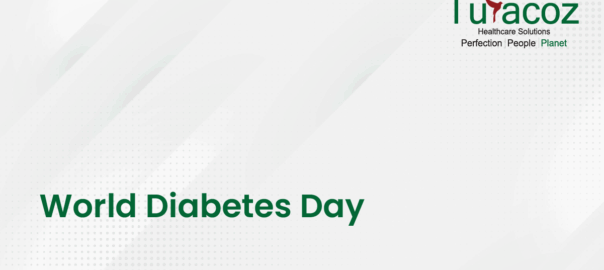The campaign “World Diabetes Day (WDD)” was launched in 1991 jointly by International Diabetes Federation (IDF) and the World Health Organization (WHO) to address the growing concerns about the rising health issues posed by diabetes. It was officially recognized by United Nations in 2006 and is marked every year on November 14th, to commemorate the birth anniversary of Sir Frederick Banting, who along with Charles Best co‑discovered insulin in 1922 (1).
The condition
Diabetes is a metabolic disorder characterized by hyperglycemia which results from defects in insulin, secretion, insulin action, or both. A long‑term uncontrolled hyperglycemia can cause damage, dysfunction, and failure of the eyes, kidneys, nerves, heart, and blood vessels (2).
Classification:
Diabetes can broadly be classified into two main categories:
- Type 1: In this case, body’s own immune system attacks and destroys the cells in pancreas that produce insulin. Although it can occur at any age, but it is prevalent more among children and young adults who require daily dose of insulin to stay alive.
- Type 2: This situation arises when body does not make or use insulin efficiently. it is the most common type and can occur at any age, but middle‑aged and older people suffer from this condition mostly.
Other forms of diabetes include: Gestational diabetes, monogenetic diabetes, and cystic fibrosis related diabetes (3).
Symptoms
Symptoms associated with diabetes in general includes:
- Increased thirst and urination
- Increased appetite
- Fatigue
- Blurred vision
- Numbness or tingling in the feet or hands
- Sores that do not heal
Unexplained weight loss (4).
Causes
- Type 1 diabetes is a result of auto immune destruction of beta cells of the pancreas. It may also occur due to certain genetic and environmental factors, such as viruses.
- Several factors are involved in causing type 2 diabetes such as obesity, physical inactivity, insulin resistance, genes, and a history of diabetes in the family.
- It is believed that gestational diabetes can be caused by hormonal changes during pregnancy along with genetic and lifestyle factors (4).
Prevalence and some statistics
- People with diabetes have risen sharply from 108 million in 1980 to 422 million in 2014. Prevalence of diabetes among adults over 18 years of age has almost doubled from 4.7% to 8.5% within the same time period.
- Prevalence of diabetes has become a serious health concern specially in middle‑and‑low‑income countries.
- As of 2016, approximately 1.6 million deaths were attributed to diabetes only and in 2012, around 2.2 million deaths were reported globally due to high blood glucose.
- As per an estimate by WHO, diabetes was the 7th leading cause of death in the year 2016 (5).
The campaign and the aim
At present WDD is the largest diabetes campaign having presence in more than 160 countries and a reach to more than 1 billion people. It is represented by a blue circle logo adopted by the UN resolution on diabetes on 2007. The color blue signifies the unity among global diabetes community against the epidemic (6).
WDD serves as:
- Platform for promoting IDF advocacy efforts throughout the year.
- Global driver to promote the importance of taking coordinated and concerted actions to confront diabetes as a critical global healthcare (1).
What’s in store for 2019?
WDD will be observed November 14th on Thursday this year which is just around the corner. On this day, millions of people around the globe organize events and activities raising awareness about diabetes (6). The campaign projects a dedicated theme every year which runs for one or more year. For the year 2019, the theme is ‘Family and Diabetes’ with an intent to raise awareness about the effect that diabetes has on the family and support network of those who are suffering as well as promoting the role of family in the management, care, prevention, and education (1).
Diabetes affecting family members
Diabetes can be considered as a family disease since the other members of the family somehow get affected if someone, specially a child is diagnosed with it. It is for this reason that it can be regarded as a form of chronic illness like any other chronic illnesses (7).
In a survey named DAWN2 involving 2000 family members of those affected by diabetes reported that 1/3rd of those experienced a notable burden and negative impact of diabetes, including effects on their emotional wellbeing, financial situation, leisure activities, and physical health (8).
Some of the risks, that family members of those affected by diabetes, experience, can be categorized as (9):
- Biological risk: it has been shown that there exists a correlation (0.34 and 0.38) on BMI ranges of those suffering from diabetes and their partners. Partners of those with diabetes have been found to have higher BMI than their counterparts with non‑diabetic partner.
- Health behavioral risk: a study involving multiethnic sample of > 500 patients suffering from type 2 diabetes and their partners showed that significant correlation exists between factors such as; consumption of fat, consumption of carbohydrates, total physical activity, and indulging in smoking and alcohol.
- Affective/emotional risk: it is reported that female partners of diabetic patients have higher mean level of depressive effect. For male partner, the mean level of depressive effect was comparatively lower but still higher than that of the control subjects.
Role of family members in diabetes management
A family can play a crucial role in managing diabetes of the affected member. Having them involved in the self‑care interventions may help in achieving positive outcomes for the diabetics (10).
Families are required to share responsibilities and reconsider role of family as a result of diabetes. Reports have suggested that low level of conflicts, unity, and efficient organization patterns are linked with better treatment adherence (11).
The Family Approach to Diabetes Management (FADM) is a novel model that focusses on determining and exploring different ways of intra family communication having either positive or negative impact on clinical outcomes while keeping patient and family self‑management at forefront. It has been shown that engagement of entire family is easy to adjust as well as cost‑effective into standard diabetes care in addition to offering positive clinical outcome pertaining to general quality of life and A1C results (12).
Studies have shown that family members while participating in health interventions for diabetes care improves their own knowledge about the disease and inculcate skills necessary to support their loved ones. Family’s participation benefits their own health behaviors and health outcomes (10).
Turacoz Healthcare Solution is committed to raise awareness about diabetes management, prevention and educating people so as to make them help their near and dear ones suffering from this chronic lifestyle disorder to maintain and live a healthy life. Family’s engagement in diabetes care can significantly improve the outcomes and also make other family members learn about the management of diabetes.
If you have any queries, email us at [email protected]
References
- About World Diabetes Day. International Diabetes Federation. Available at: https://worlddiabetesday.org/about/
- Diagnosis and classification of diabetes mellitus. American Diabetes Association; 2013: 36(S1). 67‑74. Available at:https://care.diabetesjournals.org/content/36/Supplement_1/S67
- What is diabetes? National Institute of Diabetes and Digestive and Kidney Disease. Available at: https://www.niddk.nih.gov/health-information/diabetes/overview/what-is-diabetes
- Symptoms and causes of diabetes. National Institute of Diabetes and Digestive and Kidney Disease. Available at:https://www.niddk.nih.gov/health-information/diabetes/overview/symptoms-causes
- World Health Organization. Available at: https://www.who.int/news-room/fact-sheets/detail/diabetes
- Getting Ready for World Diabetes Day 2019. Diabetes self‑management. Available at: https://www.diabetesselfmanagement.com/blog/getting-ready-world-diabetes-day-2019/
- The family approach to diabetes management: Theory into practice toward the development of a new paradigm. Diabetes Spectrum. 2004; 17(1): 31‑36. Available at: https://spectrum.diabetesjournals.org/content/17/1/31
- Family matters in diabetes. The Lancet Diabetes and Endocrinology. 2018; 12(6): 911. Available at: https://www.thelancet.com/journals/landia/article/PIIS2213-8587(18)30317-6/fulltext
- Fisher L. Family relationships and diabetes care during the adult years. Diabetes Spectrum. 2006; 19(2): 71‑74. Available at: https://spectrum.diabetesjournals.org/content/19/2/71
- Baig AA, Benitez A, Quinn MT et al. Family interventions to improve diabetes outcomes for adults. 2015; 1353(1): 89‑112. Available at: https://www.ncbi.nlm.nih.gov/pmc/articles/PMC4624026/
- Ahmed Z, Yeasmeen F. Active family participation in diabetes self‑care. A commentary. Diabetes Management. 2016; 6(5): 104‑107. Available at: https://www.openaccessjournals.com/articles/active-family-participation-in-diabetes-selfcare-a-commentary.pdf
- Solowiejczyk J. The family approach to diabetes management: Theory into practice toward the development of a new paradigm. Diabetes Spectrum. 2004; 17(1): 31‑36. Available at: https://spectrum.diabetesjournals.org/content/17/1/31










